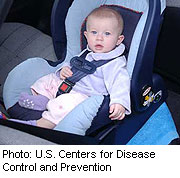
MONDAY, March 21 (HealthDay News) — Children are best kept in rear-facing car seats until age two or until they have reached the height and weight maximums set by the car seat manufacturer, according to new recommendations from a pediatricians’ group.
This is a significant change from the prior recommendations, which called for babies to stay in rear-facing seats until they were at least one years old and 20 pounds. Rear-facing seats offer more support to the head, neck and spin of infants and toddlers in a crash, said report author Dr. Dennis Durbin, a pediatric emergency physician at the Children’s Hospital of Philadelphia.
The new guidelines, developed by the American Academy of Pediatrics, appear in the April 2011 issue of Pediatrics.
Though the recommendations were meant to encourage parents to keep kids in the seats longer, many parents interpreted that wording to mean they should put their children in a forward facing seat at their first birthday — way too soon, said Dr. Benjamin Hoffman, an associate professor of pediatrics at the University of New Mexico and a certified car passenger safety technician and instructor who was not involved in the report.
“There’s been this perception that it’s a good idea to move from rear-facing to forward-facing,” Hoffman said. “But if parents want to afford their child the best possible protection from the leading cause of death for children, they want delay that step as long as they can.”
Most rear-facing child safety seats today can accomodate children to fit the new guidelines, the report noted.
The rate of deaths due to motor vehicle crashes in children under age 16 fell 45 percent between 1997 and 2009, according to background information in the article.
Yet motor vehicle accidents are still the leading cause of death for children ages 4 and older. Each year, more than 1,500 children under age 16 are killed annually in motor vehicle accidents. And for every death, some 18 children are hospitalized and 400 are hurt seriously enough to require medical attention, according to the article.
A 2007 study in the journal Injury Prevention found that children under age 2 are 75 percent less likely to die or be severely injured in a crash if they’re in a rear-facing car seat.
And even age two shouldn’t be read as a deadline, Durbin said. If your child is small for his or her age, you may want to delay turning around the seat even longer, while bigger, taller kids may need to be turned sooner than age two.
The recommendations also say that a forward-facing car seat with a harness offers more protection than a booster seat, while a booster seat is better than a seat belt alone.
Kids should be kept in a forward-facing car seat as long as possible, even through age 8 if their weight or height is under the limit allowed by their child safety seats, according to the new guidelines. Studies show that the car seats reduce the risk of child injury up to 82 percent and the risk of death by 28 percent, compared to wearing seat belts.
“Car seats have more structure — particularly side structure — to them than most booster seats,” Durbin said. “This added structure may offer additional protection, particularly in side impact crashes. In addition, most car seats sold today use 5-point harness systems which do a better job of restraining a child in the event of a crash than the 3-point vehicle seat belt, even when positioned properly with a booster seat.”
Parents are also advised to keep older children in a booster seat, which properly positions the seat belt, until they’re 4 feet 9 inches tall and are between the ages of 8 and 12. The average child reaches that stature sometime after age 10, Hoffman said.
Booster position the seat belt so that the shoulder belt lies across the middle of the chest and shoulder and keeps it off the neck or face, while the lap belt fits low and snug on the hips and upper thighs, not across the soft tissue of the belly.
Prior research shows booster seats can reduce the risk of injury by 45 percent in 4- to 8-year olds compared to kids of that age in seat belts.
“Keep your children as safe as possible on every trip you take by delaying the transitions that you make between different types of car seats for as long as possible,” Durbin said. “With each transition you make — from a rear-facing to a forward-facing car seat, from the car seat to a booster seat and from the booster to the vehicle seat belt — you give up some protection and your child is more likely to be injured in a crash.”
Children should ride in the backseat until they are 13 years old, since studies have shown this reduces the risk of injury by 40 to 70 percent, the AAP added.
The pediatricians’ group also recommended that child safety seats not be used outside the car — as they often are — since they can tip and fall off tables, countertops and other surfaces. More than 8,000 infants a year are injured in each year when child safety seats are used improperly or for unintended purposes, a supplemental report warned.
“Following these guidelines will give parents peace of mind that they are doing the best job they can of protecting their children from injury in the event of a car crash,” Durbin said.
The typical forward-facing car seat fits children up to about 40 pounds, though there are more than 40 models that can accommodate kids up to 60, 65 or even 85 pounds, Hoffman said.
More information
The American Academy of Pediatrics has more on car seat safety.

